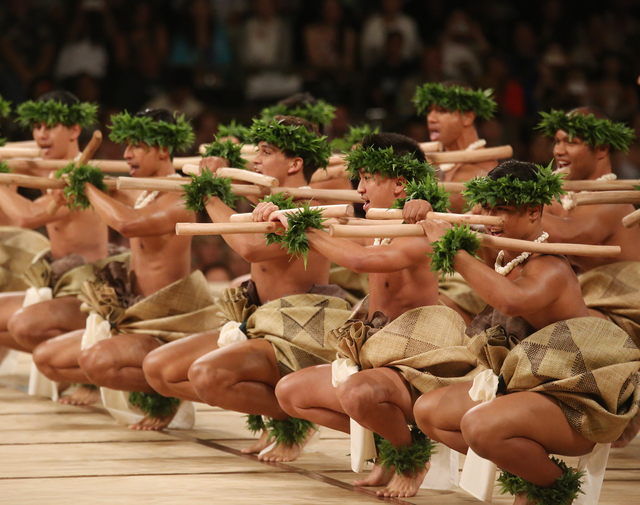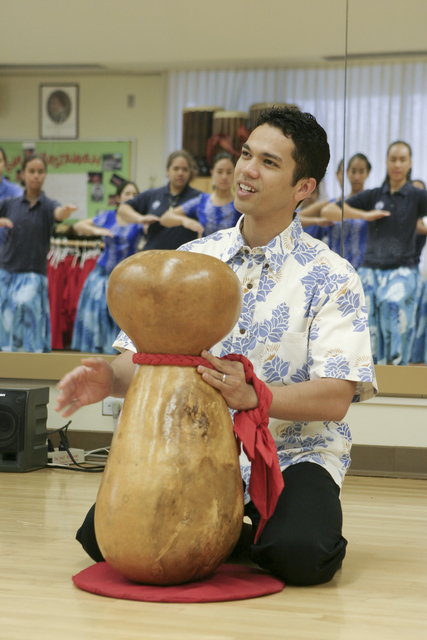At 39, Kaleo Trinidad is among the younger kumu hula in the 52nd Annual Merrie Monarch Festival.
That said, Trinidad and his halau, Ka Leo O Laka I Ka Hikina O Ka La, enter this year’s competition at hula’s pinnacle. Last year, his kane took first place in hula kahiko, second place in hula ‘auana, took the overall kane title and brought home the Lokalia Montgomery Perpetual Trophy with the highest combined score in the competition, 1,194 points.
In addition to his halau, Trinidad is kumu hula for Kamehameha Schools Kapalama’s Performing Arts Department and one of the school’s Ho‘ike directors. He understands that with success comes scrutiny, which means the spotlight will shine brighter on his charges this year.
“Coming back this year it’s different because we were champions last year,” he said. “I think everybody just tries to do their best, and if they win something, that’s great. The year before, we didn’t place at all. In a way, that was kind of nice, because there were no expectations. But we’re coming back really humble, because we know what it feels like to win — and we know what it feels like to not win.”
Although the victory may have been unexpected, Trinidad and his halau weren’t exactly flying below the radar. In 2011, his men won the kane ‘auana with a showy, memorable homage to legendary waterman and Hawaiian Olympian Duke Kahanamoku. The lead dancer, portraying Kahanamoku, high-stepped offstage to dance at floor level, shaking the hand of Mayor Billy Kenoi and planting a kiss on the cheek of hizzoner’s better half, Takako. The halau finished runners-up in kane kahiko and kane overall to the late kumu hula O’Brien Eselu and Ke Kai O Kahiki.
In 2012, they placed third in kane kahiko, ‘auana and overall.
Trinidad said that after being shut out of the hula hardware race in 2013, he was “just really praying for fourth place” last year.
“I would have taken the fourth place trophy home and been completely happy with fourth place,” he said. “When (stadium and TV announcer Kimo Kahoano) goes to third place, you get a little nervous, because you just had a chance to get fourth place, and there are others left and less positions for you to be called. I was surprised and I was happy for the work that the boys did.”
In addition to his kane, Trinidad also has a contestant for Miss Aloha Hula, Tifeni Gene Ann Kanoe Elvenia. She graduated from the University of Hawaii at Hilo in 2012 with a dual major in Hawaiian language and communication, and served as the local university’s student commencement speaker.
Asked how things have changed since last year’s championship, Trinidad replied, “I think I’m the same person,” and laughed.
“We always strive hard to just do our best for ourselves,” he said. “But now, a lot of people recognize us. We have a stronger presence in the community and we go out into the community and do good and positive things. That’s how I believe I’ve changed and our halau has changed, that we can do more in the community with what we have. Because people recognize us now because of that win, and that’s a responsibility.”
As a haumana, Trinidad has had the good fortune to learn from several esteemed kumu, including Holoua Stender, Randie Kamuela Fong, Chinky Mahoe and the late Wayne Keahi Chang.
The kahiko mele Trinidad’s kane will perform is “He Inoa No Keopuolani,” a hula pahu, or drum dance, composed by Fong.
“It’s describing the birth of the chiefess, Keopuolani. It speaks of her very, very sacred genealogy. She could be considered the highest-ranking chiefess ever to be born in Hawaii. This is Kamehameha’s sacred wife,” Trinidad said. “It will seem very, very traditional to everyone. To me, it’s an authentic example of a hula pahu.”
The halau’s ‘auana mele will be “Beauty Hula,” Trinidad said, “in honor of Manoa Valley on Oahu.”
The choreography to the classic Johnny Almeida song is inspired by Fong, Trinidad said.
“The boys will be dancing with implements, kala‘au (sticks) and ipu (gourd drums),” he explained. “We will be using two different implements at the same time, which is unusual. Usually, it’s one at a time.
“This year, we’re doing a kahiko and an ‘auana that were given to me by my kumu. It’s even more important that we do a good job, when I’m given something that’s part of a legacy. People always say this but it’s really true. I’m hoping that my kumu will be proud of me. Because he’s still alive; he’ll be watching.
“When I decided I was going to be performing these particular hula, I asked if I could meet with him and I could bring a couple of dancers and we could go over it and be sure that everything we did was right from what he felt and what he saw,” he said. “So I’m hoping that what we perform and how we perform it and the spirit of what we bring onto the stage is exactly what my kumu expects. Because if my kumu’s happy, it doesn’t matter if we win or if we lose, because that’s his legacy. That’s what he passed on. For me, a win this year would be making my kumu happy.”
Although hula is a tradition-driven art, young blood is vital to perpetuate the tradition. Trinidad said it’s up to him and others in his generation “to build on the foundation that the generation before gave us.”
“That’s really the magic of what we have,” he said. “All of the knowledge that we were taught, to be inspired by it and bring it forward.”









